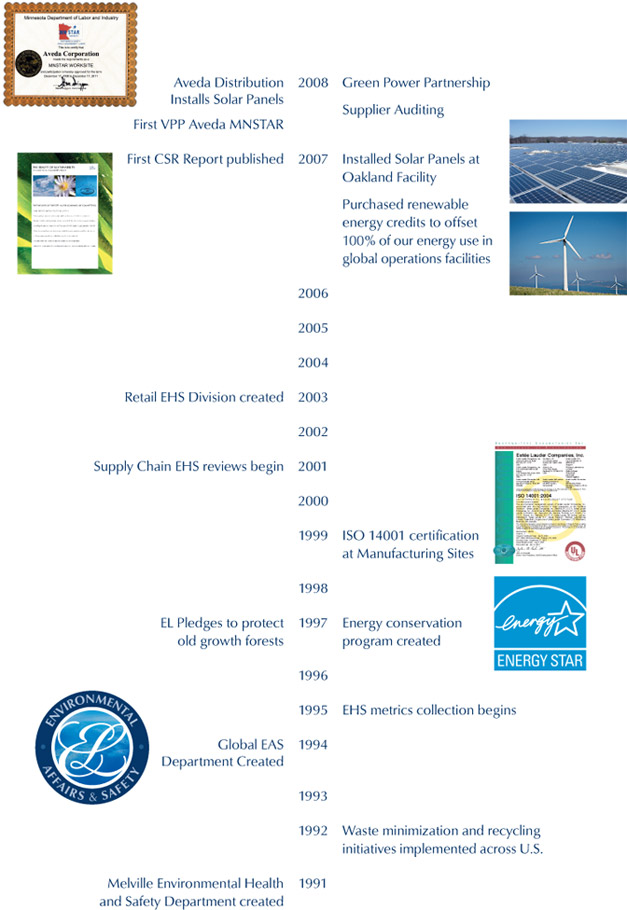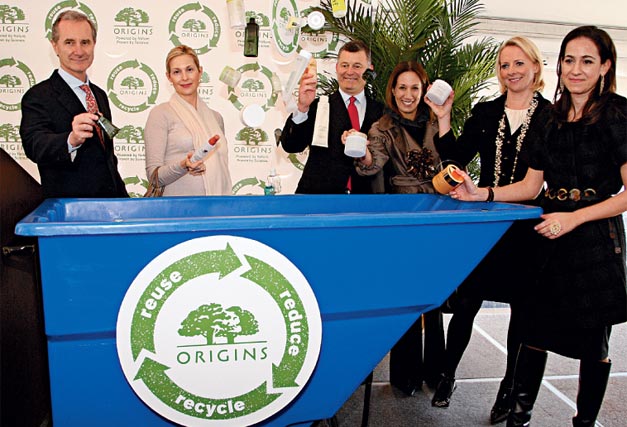ENVIRONMENTAL STEWARDSHIP
In 1991, long before environmental sustainability planning became an expected business practice, a small
group of innovative senior executives at ELC realized the need for a unified approach to environmental
programs and communications and formed ELC's Environmental Affairs and Safety (EAS) Committee.
Today, the EAS Committee has seven subcommittees that are responsible for informing our activities in the
areas of products, facilities, packaging, employee safety and health, reporting, supply chain and share holders.
The EAS Committee is chaired by the Executive Vice President of Global Supply Chain, who provides
periodic EAS Committee updates to the Board of Directors.

INGREDIENT BASE. OUR USE OF NATURAL AND ORGANIC
MATERIALS IS GROWING AS WE CONTINUE TO LEARN
MORE ABOUT THESE INGREDIENTS. IN FISCAL 2008,
A TEAM TASKED WITH DETERMINING NATURAL, ORGANIC
AND GREEN COMPANY PRIORITIES WAS FORMED.
Our EAS Department is tasked with maintaining compliance with all applicable laws and our ISO 14001 accredited Environmental Management System and internal Occupational Safety and Health Management System. The Department also works closely with environmental groups and government agencies such as the United States Environmental Protection Agency's (EPA) Energy Star program to improve our programs and performance.
ENERGY
Under the direction of the EAS Committee, the Company has developed a comprehensive program
to achieve reductions in energy usage. Our efforts and partnership with groups such as Energy Star, the
U.S. EPA Climate Leaders and Green Power Partnership have led to the following accomplishments:
- The installation of on-site renewable energy to power our facilities where economically feasible
- The purchase of carbon offsets for our electricity use where we cannot reduce or create our own clean energy. The combined global renewable energy credits purchases yielded an annual renewable electricity purchase of more than 77,745 MWh for the Company in fiscal 2008. These purchases allow us to avoid the release of 34,959 tonnes of carbon dioxide equivalent into the atmosphere each year
- The installation of solar photovoltaic arrays yielding more than 660 kW of energy at facilities in Oakland, NJ, Rancho Dominguez, CA and Lachen, Switzerland. These arrays allow us to avoid the release of more than 9,000 tonnes of carbon dioxide into the atmosphere each year
GREENHOUSE GAS (GHG) EMISSIONS
In 2009, ELC completed its first GHG inventory in which our total of combined emissions was 168,824
metric tonnes carbon dioxide equivalent. Of this, we offset 86,079 metric tonnes of emissions through the
use of renewable energy and renewable energy offsets. The GHG inventory was compiled in accordance
with The Greenhouse Gas Protocol: Corporate Accounting and Reporting Standard and the U.S. EPA Climate
Leaders Design Principles Guidance and included emissions from our globally owned and leased manufacturing,
warehouse, distribution, office and retail spaces, along with emissions from business travel and the
direct use of our products by consumers. The GHG inventory includes estimates of the GHG emissions
associated with energy and fuel consumption in locations where data was unavailable.

In fiscal 2009, we provided a detailed report of our emissions to the Carbon Disclosure Project, an independent, not-for-profit organization that holds the largest database of corporate climate change information in the world. A full breakdown of our emissions and methodologies is available on the Carbon Disclosure Project website at: http://www.cdproject.net.
WATER
We see opportunity for innovation and improvement in our global water usage. We track water usage at all
our locations and have implemented many conservation measures to reduce the water used for process
cleaning, sanitation and irrigation. We are currently developing a comprehensive plan to further minimize
our water footprint.
RECYCLING
We strive to design our products in a way that minimizes manufacturing waste and emphasizes recycling as
the best option for managing any waste generated. In fiscal 2008, our manufacturing facilities expanded their
onsite recycling programs and conducted comprehensive waste audits to identify and segregate materials for
more efficient recycling.